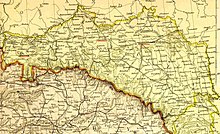Bukovina District
Bukovina (1775–1786) Bukowina; also Buchenland Bukovina District / Chernivtsi District (1786–1849) Kreis Bukowina / Kreis Czernowitz | |||||||||
|---|---|---|---|---|---|---|---|---|---|
| 1775–1849 | |||||||||
Flag of Galicia and Lodomeria (1775–1849)
| |||||||||
 Territorial evolution of the Kingdom of Galicia and Lodomeria, which used to include Bukovina | |||||||||
| Capital | Czernowitz (Cernăuți / Chernivtsi) | ||||||||
| Common languages | German, Romanian, Ukrainian | ||||||||
| History | |||||||||
• Habsburg annexation of Bukovina into Galicia and Lodomeria as a military district | 1775 | ||||||||
• Bukovina becomes a formal district of Galicia and Lodomeria | 1786 | ||||||||
• Establishment of the Duchy of Bukovina | 1849 | ||||||||
| |||||||||
| Today part of | Romania Ukraine | ||||||||
The Bukovina District (German: Kreis Bukowina), also known as the Chernivtsi District (German: Kreis Czernowitz), was an administrative-territorial unit of the Kingdom of Galicia and Lodomeria[1] within the Habsburg monarchy in Bukovina, annexed from Moldavia.[2][3] It was first a military district from 1775 to 1786 until it was officially incorporated into Galicia and Lodomeria as its own district.
Geographical location

The Bukovina district occupied the area between the Carpathians mountains and the Seret, from the middle reaches of the Dniester to about the middle reaches of Moldavia. It was located in the east of the Austrian Empire and in the southeast of the Kingdom of Galicia and Lodomeria.
Western Bukovina was part of the Habsburg monarchy from the second half of 1774 . Until May 1775 as a temporary military administrative-territorial unit - Chernivtsi General.[4] It was join the Kingdom of Galicia and Lodomeria, and the south (districts of Seret and Suceava, and Dovgopol district) to the Kingdom of Hungary.
However, such intentions were strongly opposed by the local population of Dovhopil region (about 90% of the population were ethnic Ruthenians and Poles), which geographically separated the mostly Romanian Suceava from Transylvania, which forced to abandon this idea.[5]
The final decision on the future management of the region was made on August 6, 1786, during the stay in Lviv of Joseph II,[6] who liquidated his Patent The Military Administration of Bukovina (as having fulfilled its mission during the transition period) and annexed the Bukovina District (in full) to the Kingdom of Galicia and Volodymyria as the Chernivtsi District, later renamed the Bukovina District.
Population
The period of the region's status as a district of the Kingdom of Galicia and Lodomeria is characterized by a significant increase in population, mainly due to immigrants, colonizers and more. The tributary was recorded by both the Romanians from Transylvania and the Ruthenians from Galicia. Germans, Poles, and mostly Jews came from different regions. In 1786, the population of the region was estimated at 91,000 inhabitants.
Prior to that, the population was rewritten exclusively for a religion that blurred the boundaries between Ruthenians (Ukrainians) and Wallachians (Romanians), generalizing them as Orthodox. According to the results of the 1846 census: 180,417 Ruthenians (Ukrainians) were recorded. (48.6%), Wallachians (Romanians) - 140,625 people. (37.9%), other nationalities (mainly Germans, Jews, Poles) - 50089 people. (13.5%).[2] Such results were obtained within the Bukovina district as a whole (northern and southern parts).
Territorial division of the district
Bukovina district was divided into four counties (until August 1, 1794 – districts) and one separate district:[7]
- Chernivtsi County ( German: Bezirk Czernowitz).
- Vyzhnytsya district
- Seret County
- Suceava County
- Dovhopil district
Each county consisted of 12 districts with 10 communities in each.
In the military organization, Bukovina district was divided into Chernivtsi and Suceava regimental districts, in the fiscal sphere - into eight tax districts.
The administrative center of the Bukovina district was the city of Chernivtsi.
References
- ^ Welisch, Sophie (March 1984). "The Second World War resettlement of the Bukovina‐Germans". Immigrants & Minorities. 3 (1): 49–68. doi:10.1080/02619288.1984.9974569. ISSN 0261-9288.
- ^ a b Stambrook, Fred (January 2004). "National and Other Identities in Bukovina in Late Austrian Times". Austrian History Yearbook. 35: 185–203. doi:10.1017/s0067237800020981. ISSN 0067-2378. S2CID 145290239.
- ^ Savelyev, Yuriy (2018). "Соціальне включення як вимір модернізації європейських суспільств. Автореферат дисертації на здобуття наукового ступеня доктора соціологічних наук (Социальная включенность как измерение модернизации европейских обществ. Автореферат диссертации на соискание ученой степени доктора социологических наук. Social Inclusion as Dimension of Modernization of European Societies. Synopsis of Doctoral Dissertation in Sociology)". SSRN Electronic Journal. doi:10.2139/ssrn.3423957. ISSN 1556-5068.
- ^ "Аурел Ончул. Румынский вопрос на Буковине". buktolerance.com.ua. Retrieved 2022-02-09.
- ^ Rechter, David (2013). Becoming Habsburg: the Jews of Austrian Bukovina, 1774–1918. ISBN 978-1-904113-95-9. OCLC 231588598.
- ^ Боярко, Ірина Миколаївна (2017-01-10). "ОРГАНІЗАЦІЯ РУХУ ІНФОРМАЦІЙНИХ ПОТОКІВ У ПРАКСЕОЛОГІЧНО-КАТАЛАКТИЧНІЙ МОДЕЛІ ІНФОРМАЦІЙНОГО ЗАБЕЗПЕЧЕННЯ СТРАТЕГІЧНОГО УПРАВЛІННЯ". Вісник Університету банківської справи. 2 (29): 62–68. doi:10.18371/2221-755x2(29)2017120622. ISSN 2221-755X.
- ^ Жук, Валентина (2020-08-07). "ОСОБЛИВОСТІ ВЖИВАННЯ ПАСИВНИХ КОНСТРУКЦІЙ (НА МАТЕРІАЛІ ТЕКСТІВ ХХ – ПОЧАТКУ ХХІ СТОЛІТТЯ)". ЗДОБУТКИ ТА ДОСЯГНЕННЯ ПРИКЛАДНИХ ТА ФУНДАМЕНТАЛЬНИХ НАУК XXI СТОЛІТТЯ - ТОМ 2. Міжнародний центр наукових досліджень. doi:10.36074/07.08.2020.v2.16. S2CID 225377054.
- Articles with short description
- Short description matches Wikidata
- Articles containing German-language text
- Pages using infobox country or infobox former country with the flag caption or type parameters
- Pages using infobox country or infobox former country with the symbol caption or type parameters
- Bukovina
- Kingdom of Galicia and Lodomeria
- 1775 establishments in the Habsburg monarchy
- States and territories established in 1775
- States and territories disestablished in 1849

![Coat of arms of Galicia and Lodomeria [pl; uk] (1805) of Bukovina](http://upload.wikimedia.org/wikipedia/commons/thumb/4/41/Middle_Coat_of_Arms_of_Francis_II%2C_Holy_Roman_Emperor_%281804-1806%29.svg/85px-Middle_Coat_of_Arms_of_Francis_II%2C_Holy_Roman_Emperor_%281804-1806%29.svg.png)